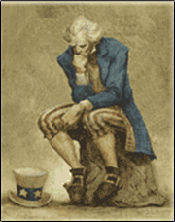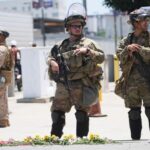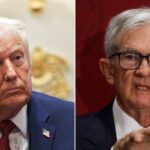
–>
August 26, 2022
Air Force general Curtis LeMay rarely gets mentioned when military historians rank America’s greatest commanders, but he should.
Most Americans, if they have ever heard of LeMay, know him from the caricatures created by Hollywood in the fictional comedy movie Dr. Strangelove (the characters Gen. Jack Ripper, played by Sterling Hayden, and Gen. Buck Turgidson, played by George C. Scott, are based on Hollywood’s view of LeMay) or the more serious movie about the Cuban Missile Crisis Thirteen Days, which portrays LeMay as the dangerous military hawk tamed by the “brilliant” and “prudent” President John F. Kennedy and his brother Robert — a theme promoted by Kennedy court historians after the crisis.
Curtis LeMay, unlike the Kennedy brothers, did not succeed because of his father’s money, political machinations, and a sycophantic media. As James Scott explains in his new book about the firebombing of Tokyo and the end of World War II, Black Snow, LeMay had a “hardscrabble” childhood, with his father frequently switching jobs and his mother cleaning houses to support their six children, of which LeMay was the oldest. LeMay at a young age worked delivering newspapers and store goods and earned extra money in high school as an ironworker. LeMay put himself through college at Ohio State, where he studied civil engineering and joined ROTC. As a young child, LeMay was fascinated by airplanes, and while in college, he decided to join the National Guard and was accepted at flight school. The rest, as they say, is history.
LeMay’s star rose quickly at the outset of World War II as he earned a reputation as the best navigator in the Army Air Corps. He wasn’t a self-promoter; his talents and work ethic led to his rise. Ralph Nutter, who served with LeMay, called him “all substance and no form.” LeMay flew B-17s from England over Germany as part of the Eighth Air Force and pioneered bomber formations that improved the accuracy of bombing while providing for increased protection for flight crews. The airmen who flew under his command viewed him with a combination of fear and awe. He was known for being tough but fair and as a leader who didn’t tolerate failure. LeMay also learned quickly that daytime bombing of military targets was costly and imprecise.
LeMay was promoted to brigadier general in 1944 and assigned to the China-Burma-India theater to conduct bombing missions over Japan. He was only 38 years old. In early 1945, he replaced Gen. Haywood Hansell on Guam to head up the 21st Bomber Command and its mission to bomb military targets on Japan’s main islands. Hansell was a member of the so-called “Bomber Mafia” that Malcom Gladwell has written about.
Hansell continued to insist on precision bombing of military targets instead of area bombing that would inevitably inflict “collateral damage” — i.e., civilian casualties — despite the fact that in 1945 there was no such thing as “precision bombing.” LeMay was chosen to replace Hansell because he understood this and was willing to do what was necessary to bring Japan to its knees.
In 1921, Italian air power theorist Giulio Douhet in his book Command of the Air envisioned air power as the decisive instrument of warfare. Douhet promoted the relentless and systematic bombing of cities to force an enemy to surrender. Air forces, he believed, should operate independently of other services. Command of the air, he explained, “means to be in a position to wield offensive power so great it defies human imagination.” Air forces, he wrote, must be “capable of crushing the material and moral resistance of the enemy.” Douhet predicted that future warfare would make no distinction between civilians and combatants. “Future war,” he wrote, “will be total in character and scope.”
Douhet predicted that in the next war, the entire territory of the enemy, including commercial and industrial establishments, government facilities, and population centers, would become targets of air power. The goal of air power, he explained, would be to “inflict the greatest damage in the shortest possible time” to bring about the “complete breakdown of the social structure” of the enemy. He called this a “dark and bloody picture” — the reality of total war.
Curtis LeMay was an intellectual disciple of Douhet. In the air war over Japan between March and August 1945, LeMay put into practice Douhet’s theories. LeMay’s B-29s relentlessly, systematically dropped incendiary bombs on Tokyo and 65 other Japanese cities, inflicting hundreds of thousands of deaths, rendering millions of people homeless, and burning and destroying over one hundred square miles of Japanese civilian population centers. He brought total war to Japan’s leaders and its people.
Scott in Black Snow describes the nighttime firebombing of Tokyo on March 9–10, 1945, from the perspectives of U.S. airmen and Japanese civilians. Military targets were hit, but more than 105,000 people lost their lives to a firestorm created by American incendiary bombs. The destruction and suffering were unprecedented, Armageddon-like. One survivor recalled that she thought the world was coming to an end.
As Douhet predicted, no distinction was made between civilians and combatants. LeMay understood that no such distinction was possible given the technology of the time. He once remarked that if you kill enough people, they will stop fighting. That is exactly what happened to end the Pacific War. The two atomic bombs that obliterated most of Hiroshima and Nagasaki brought Douhet’s vision to its ultimate reality. The two super-bombs and LeMay’s relentless attacks effectively brought the war to an end.
At the time, LeMay was featured on the cover of national magazines and lauded as a hero. He went on to command the Strategic Air Command and serve on the Joint Chiefs of Staff. He was a staunch anti-communist who wanted to strike and invade Cuba during the Cuban Missile Crisis, who ridiculed arms control, who criticized American presidents for failure to win the Vietnam War, and who served as George Wallace’s running mate in 1968. LeMay’s biographer Warren Kozak called LeMay “America’s most innovative and … controversial military commander.” Kozak noted that LeMay ordered the deaths of nearly a half-million people, yet “by killing so many human beings, LeMay saved millions more by making an invasion of Japan unnecessary.” Kosak wrote that LeMay accomplished this because he had a “ruthless sense of realism.”
As we approach another anniversary of Japan’s formal surrender in World War II, we should remember one of the great military commanders who brought about the war’s end. Both during and after the American Civil War, Gen. Ulysses Grant was called a “butcher” for the way he conducted warfare. LeMay in 1945, like Grant, in the 1860s, understood the nature of warfare at the time and acted accordingly. Grant is considered one of America’s greatest commanders. LeMay should be, too.

Image: Air Force Archive via Wikimedia Commons, CC BY-SA 4.0.
<!– if(page_width_onload <= 479) { document.write("
“); googletag.cmd.push(function() { googletag.display(‘div-gpt-ad-1345489840937-4’); }); } –> If you experience technical problems, please write to [email protected]
FOLLOW US ON
<!–
–>
‘); }
<!– _qoptions={ qacct:”p-9bKF-NgTuSFM6″ }; ![]() –> <!—-> <!– var addthis_share = { email_template: “new_template” } –>
–> <!—-> <!– var addthis_share = { email_template: “new_template” } –>







